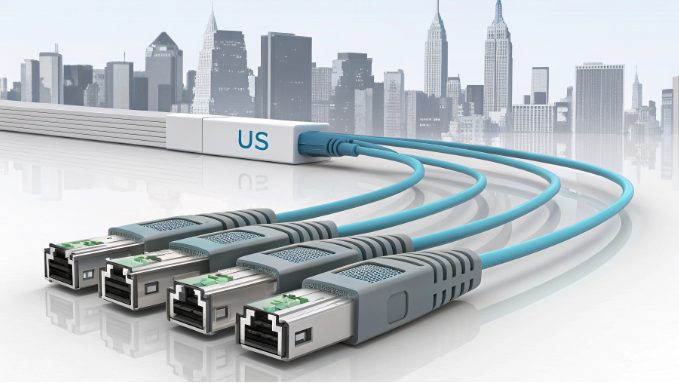Can Dedicated Internet Lines in the U.S. Be Moved?

In the evolving landscape of network infrastructure, the relocation of US dedicated lines has become a crucial consideration for IT architects and system administrators. This comprehensive technical guide delves into the intricacies of dedicated line relocation, addressing both the theoretical framework and practical implementation aspects that network engineers need to understand.
Technical Feasibility Analysis of Dedicated Line Relocation
From a technical standpoint, the relocation of dedicated lines involves multiple layers of complexity. The feasibility depends on several critical factors: physical infrastructure availability, carrier network topology, and logical network design. Modern dedicated lines utilize MPLS (Multiprotocol Label Switching) technology, which offers greater flexibility in terms of physical endpoint modifications compared to traditional circuit-switched networks.
Understanding Migration Types and Their Technical Implications
Network engineers must differentiate between two primary relocation scenarios: intra-city and inter-city migrations. Each type presents unique technical challenges and requires specific architectural considerations:
Intra-city Migration Architecture
– Layer 2 connectivity preservation
– VLAN reconfiguration requirements
– Last-mile circuit provisioning
– Bandwidth capacity planning
– Redundancy design modifications
Inter-city Migration Complexities
– BGP routing adjustments
– Latency impact assessment
– Quality of Service (QoS) recalibration
– Geographic redundancy considerations
– Carrier POP accessibility evaluation
Critical Technical Considerations During Relocation
The migration process necessitates careful attention to several technical parameters that directly impact network performance and stability. Let’s examine these critical elements through a systematic approach:
Bandwidth and Latency Optimization
During relocation, engineers must consider the following metrics:
– Round-trip time (RTT) variations
– Throughput capacity verification
– Jitter tolerance thresholds
– Packet loss monitoring baselines
– Traffic pattern analysis and adjustment
Implementation Protocol: Step-by-Step Technical Guide
A successful dedicated line relocation requires a precisely orchestrated implementation protocol. Here’s a detailed technical breakdown of the process:
Phase 1: Pre-migration Analysis ├── Network topology documentation ├── Performance baseline establishment ├── Bandwidth utilization assessment ├── Critical application mapping └── Dependency chain analysis Phase 2: Technical Implementation ├── Circuit provisioning ├── Router configuration ├── BGP session establishment ├── QoS policy implementation └── Failover testing
Technical Specifications for Different Migration Scenarios
Different migration scenarios require specific technical approaches. Consider the following configuration matrices:
| Migration Type | Technical Requirements | Implementation Time |
|---|---|---|
| Same Building | Layer 2 reconfiguration | 4-8 hours |
| Cross-City | Full circuit reprovisioning | 2-5 business days |
| Cross-State | New POP setup + BGP reconfiguration | 5-10 business days |
Advanced Technical Considerations
Network architects must account for several advanced technical factors during the relocation process:
- IPv6 transition implications
- MPLS tag preservation requirements
- VRF configuration maintenance
- Route redistribution policies
- High availability design modifications
Technical FAQ and Troubleshooting Guide
Understanding common technical challenges and their solutions is crucial for successful dedicated line relocation. Here’s a comprehensive analysis of frequently encountered issues:
Q: How do you handle BGP sessions during migration?
A: Implement a staged BGP migration approach:
– Establish new BGP sessions
– Verify route propagation
– Implement AS-path prepending
– Gradually shift traffic
– Monitor convergence metrics
Q: What’s the impact on existing IP addressing?
A: IP addressing modifications depend on the relocation scope:
– Intra-city moves often maintain existing IP blocks
– Cross-region migrations may require new IP assignments
– Consider implementing Anycast for critical services
Best Practices for Technical Implementation
To ensure optimal results during dedicated line relocation, network engineers should follow these technical best practices:
- Implement comprehensive monitoring before, during, and after migration
- Set up SNMP traps
- Configure NetFlow analysis
- Enable detailed logging
- Create detailed rollback procedures
- Document configuration snapshots
- Maintain backup circuits
- Test failover mechanisms
Technical Testing and Validation Protocol
Implement this systematic testing protocol to validate the relocated connection:
Validation Checklist: ✓ Latency baseline comparison ✓ Throughput verification ✓ BGP convergence testing ✓ Failover scenario simulation ✓ Application performance metrics
Conclusion and Technical Recommendations
The relocation of US dedicated lines is a complex but manageable process when approached with proper technical planning and execution. Network engineers should focus on maintaining service continuity while optimizing performance in the new location. Remember to consider future scalability requirements and potential technical debt when implementing the migration solution.
For optimal results in dedicated line relocation projects, always engage with experienced network architects and consider the technical implications of cross-regional network infrastructure changes. Whether you’re managing hosting environments or planning colocation strategies, proper technical execution ensures minimal disruption to your network services.

